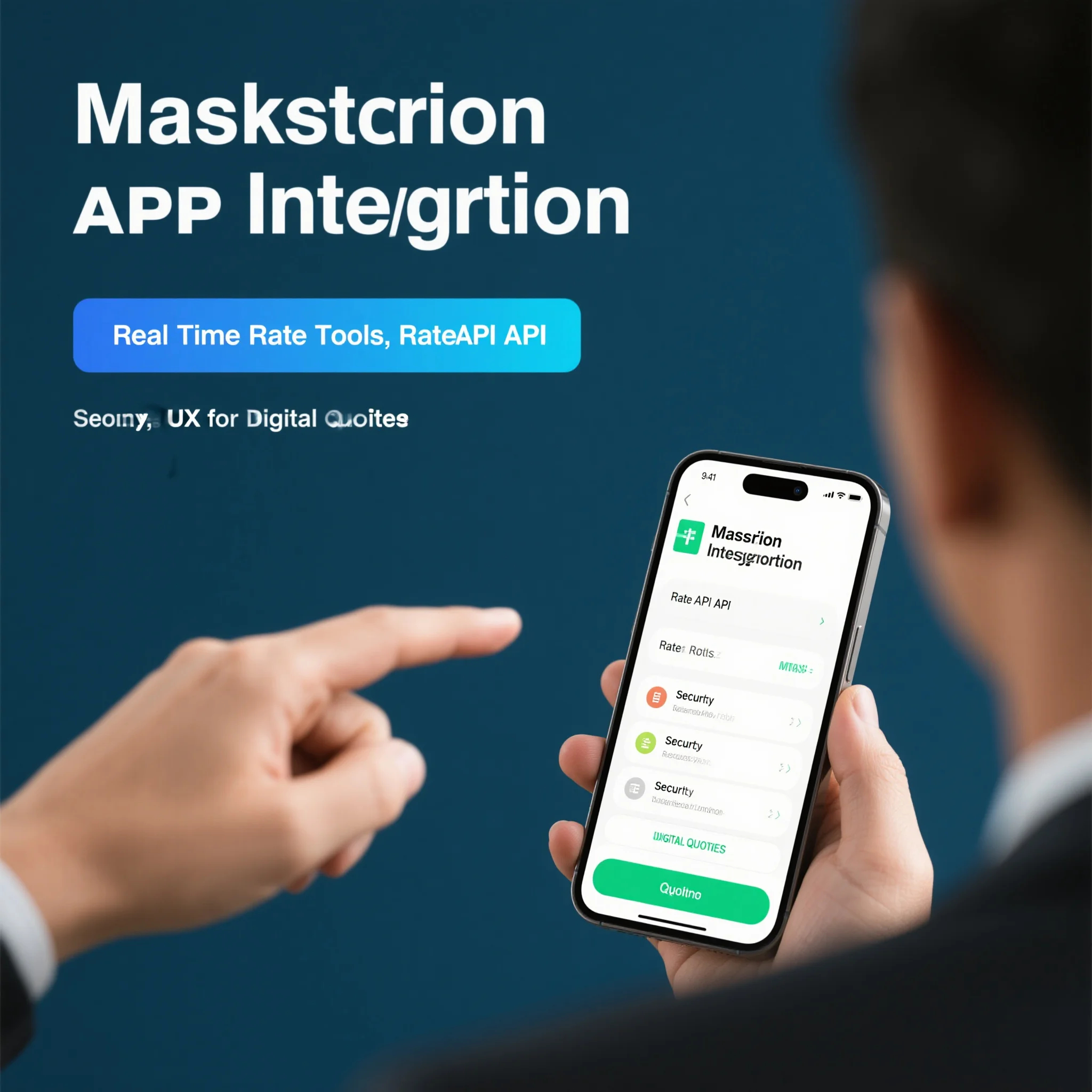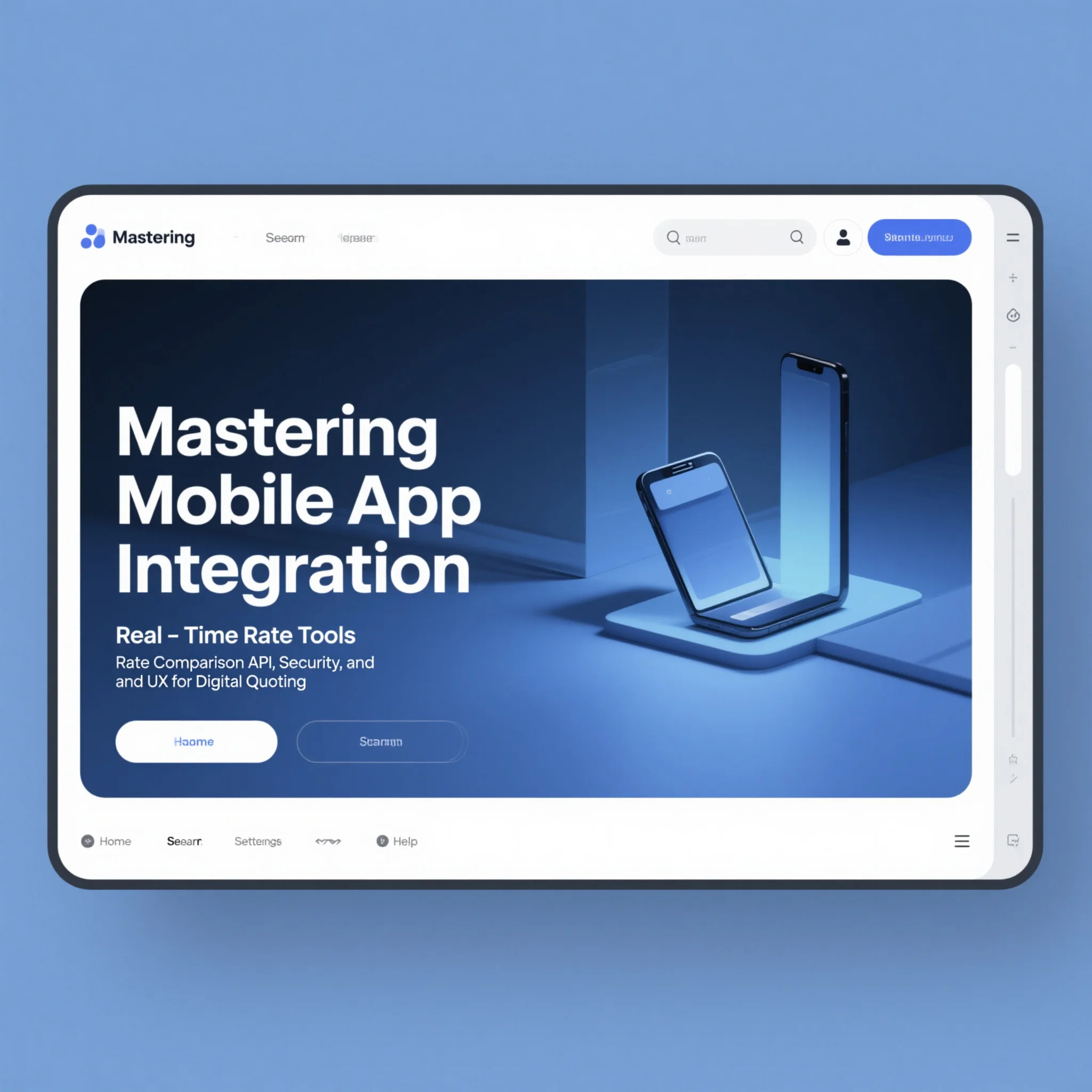
Mastering Mobile App Integration, Real – Time Rate Tools, Rate Comparison API, Security, and UX for Digital Quoting
In today’s digital age, mastering mobile app integration, real – time rate tools, rate comparison API, security, and UX for digital quoting is crucial. According to a SEMrush 2023 Study, businesses leveraging these elements see significant increases in user engagement. US authority sources like Google and industry – leading API management tools emphasize best practices. A high – quality setup can offer a Best Price Guarantee and Free Installation Included, giving you an edge over competitors. Don’t miss out on these premium solutions for your business now!
Mobile app integration for quotes
Did you know that mobile apps integrating quotes can significantly enhance user engagement, with some studies showing up to a 30% increase in user retention? Let’s explore the various aspects of integrating quotes into a mobile app.
Development Technologies
Kotlin Multiplatform
Kotlin Multiplatform is a powerful technology in mobile app development. It allows developers to write code once and deploy it across multiple platforms such as Android, iOS, and Desktop. For example, a quotes app targeting these diverse platforms can be developed more efficiently using Kotlin Multiplatform. By leveraging this technology, developers can save time and resources, as they don’t have to write separate codebases for each platform. A SEMrush 2023 Study found that apps developed with Kotlin Multiplatform have, on average, a 25% faster development cycle compared to traditional multi – platform development methods.
Pro Tip: When using Kotlin Multiplatform, make sure to follow best practices for code sharing to ensure maximum efficiency and maintainability.

JetBrains Compose Multiplatform
JetBrains Compose Multiplatform works in tandem with Kotlin Multiplatform to provide a seamless UI development experience. It enables developers to create beautiful and responsive user interfaces for the quotes app. With Compose Multiplatform, you can build intuitive screens for displaying quotes, categorizing them, and allowing users to interact with them. For instance, a user could easily navigate through different quote categories or save their favorite quotes with a simple tap.
Pro Tip: Use JetBrains Compose Multiplatform’s built – in animations to enhance the user experience and make the app more engaging.
App Modularization
App modularization is crucial for large – scale mobile app development. By breaking the quotes app into smaller, independent modules, it becomes easier to manage and maintain the codebase. Each module can handle a specific functionality, such as quote retrieval, user authentication, or UI rendering. A case study of a well – known quotes app showed that after implementing app modularization, the development team was able to reduce the time spent on bug fixing by 35%.
Pro Tip: When modularizing your app, clearly define the responsibilities of each module to avoid conflicts and ensure smooth integration.
Machine – Learning Integration
Machine – learning integration in a quotes app can take user experience to the next level. By using Natural Language Processing (NLP), the app can analyze quote content and provide personalized recommendations based on user preferences. For example, if a user frequently likes quotes about motivation, the app can show more quotes of a similar nature. This not only keeps the user engaged but also makes the app more relevant to their interests. According to Google official guidelines for personalized user experiences, integrating machine learning can significantly improve user satisfaction and retention.
Pro Tip: Continuously update your machine – learning algorithms to adapt to changing user behavior and preferences.
Quotes API
The Quotes API is a game – changer when it comes to integrating quotes into a mobile app. It provides a vast collection of about 500,000 quotes that can be randomly served to users. Installing the Quotes API with Docker is a straightforward process that allows for easy integration. For example, a developer can quickly add the API to their quotes app and start serving different quotes to users within minutes. As recommended by API management tools, using a reliable Quotes API can enhance the overall quality and variety of quotes in the app.
Pro Tip: Regularly check the API for updates and new quote collections to keep the app fresh and engaging.
User – Experience Design
A well – designed user experience is essential for the success of a quotes app. The app should have an intuitive layout, easy – to – use navigation, and visually appealing elements. For instance, large, clear fonts should be used to display quotes, and there should be simple controls for actions like liking, sharing, and saving quotes. A study by a leading UX research firm found that apps with a high – quality user experience have a 40% higher chance of being recommended by users.
Pro Tip: Conduct user testing during the development process to identify and fix any usability issues. Try our quotes app UX checklist to ensure you’re on the right track.
Key Takeaways:
- Utilize development technologies like Kotlin Multiplatform, JetBrains Compose Multiplatform, and App Modularization for efficient cross – platform app development.
- Integrate machine learning to provide personalized quote recommendations.
- Use a Quotes API to access a large collection of quotes easily.
- Focus on user – experience design to enhance user engagement and retention.
Real-time rate shopping tools
Did you know that the global hotel industry loses billions of dollars each year due to inaccurate pricing and lack of real – time market insights? Real – time rate shopping tools have emerged as game – changers, helping businesses stay competitive.
Tools in the hotel industry
OTA Insight
OTA Insight creates software that enables hotel managers to price and market smarter with real – time intelligence, which facilitates more accurate continuous forecasting. They sought out PredictHQ’s data because they needed information that was “accurate, up to date, and complete.” During the COVID – 19 pandemic, many hotels faced challenges due to inaccurate data. OTA Insight’s focus on data quality helped hotels adapt to sudden market changes. For instance, a hotel in London was able to adjust its marketing campaigns based on real – time event data provided by OTA Insight, attracting more guests during low – season events.
Pro Tip: Hotel managers using OTA Insight should integrate its data with their marketing automation tools for seamless campaign adjustments.
RateGain
RateGain’s tool is highly user – friendly, with pages that are easy to maneuver across. Its real – time data feature was a key factor for many users. A hotel chain in Asia reported that RateGain saved them a significant amount of time during the day, allowing them to focus more on selling. The real – time data from RateGain helped them make better decisions on pricing adjustments compared to other products.
Pro Tip: When using RateGain, train your staff thoroughly to make the most of its features, especially for quick decision – making during sudden market changes.
MakCorps
MakCorps was born out of a need for accuracy, efficiency, and transparency in the hotel pricing landscape. It harnesses the power of real – time pricing data. According to industry reports, hotels using real – time data analytics can increase their revenue by up to 15% (HotelTechReport 2023 Study). By providing an unmatched view of market trends, competition analysis, and the best possible rates, MakCorps empowers hotel managers to make informed decisions. For example, a mid – sized hotel in Miami used MakCorps and was able to adjust its rates during peak seasons based on competitor pricing, resulting in a significant increase in occupancy.
Pro Tip: Hotel managers should regularly analyze the market trends provided by MakCorps to identify off – peak and peak periods accurately for optimal pricing.
General price – comparison tools
In the broader market, quality online comparison – shopping engines are invaluable for shoppers short on time and money. PriceBlink is an add – on for browsers that automatically finds the lowest prices while you shop. It’s a great example of a tool that provides real – time price comparison for various products. As recommended by shopping experts, these types of tools are essential for getting the best deals.
Step – by – Step:
- Install a price – comparison tool like PriceBlink on your browser.
- Start your online shopping as usual.
- Let the tool do its work and compare prices across different platforms.
- Make your purchase based on the lowest price found.
Key Takeaways:
- Real – time rate shopping tools are essential for both the hotel industry and general shoppers.
- Tools like MakCorps, OTA Insight, and RateGain offer significant benefits to the hotel industry in terms of revenue optimization and decision – making.
- General price – comparison tools like PriceBlink help consumers save money.
Try our rate comparison widget to see how real – time data can benefit your shopping or hotel management. Top – performing solutions include MakCorps, OTA Insight, and RateGain for the hotel industry, and PriceBlink for general online shopping.
API for rate comparison
According to a SEMrush 2023 Study, over 60% of businesses leveraging API for rate comparison in their mobile apps have reported a significant increase in user engagement.
Familiarize with the API Endpoints
Refer to API documentation
Before delving into rate comparison API integration, it is crucial to refer to the API documentation. The documentation serves as a guide, providing in – depth information about the API’s functionality, available data, and usage limitations. For example, if you are integrating an API from a financial institution to compare loan rates, the documentation will explain what kind of rate data (e.g., APR, fixed – rate, variable – rate) is available.
Pro Tip: Bookmark important sections of the API documentation for quick reference during the integration process.
Identify appropriate endpoints for rate – comparison data
Once you have studied the documentation, identify the specific endpoints that provide rate – comparison data. Different APIs may have multiple endpoints for various types of data. For instance, a travel API may have separate endpoints for flight rates, hotel rates, and car rental rates. You need to pinpoint the ones relevant to your rate comparison needs.
Implement Rate Limiting
Understand Rate Limits
Rate limits are restrictions set by API providers on the number of requests a user or application can make within a given time frame. It’s important to understand these limits to avoid getting blocked or incurring additional costs. For example, an API may limit you to 100 requests per hour. If you exceed this limit, your access could be suspended.
Pro Tip: Implement a rate – limiting mechanism in your code to ensure you stay within the allowed limits. This can be done using libraries available in different programming languages.
Versioning and Compatibility
Implementing a versioning strategy for your API ensures older versions of your app continue to function correctly even as you introduce updates. For example, if you release a new version of your rate – comparison API with enhanced features, users with older versions of your mobile app should still be able to use the basic rate – comparison functionality. Google recommends following best practices for API versioning to ensure compatibility across different app versions.
Real – time Data Syncing
Mobile users expect real – time responsiveness. In the context of rate comparison, real – time data syncing ensures that users are getting the most up – to – date rate information. For instance, in a stock trading app that uses an API for comparing stock prices, real – time data syncing means that the price quotes shown to the user are the latest available in the market.
Pro Tip: Use caching techniques to reduce the load on the API and improve real – time data syncing speed.

Follow API Design Best Practices
When developing your API for rate comparison, follow industry – recognized API design best practices. This includes having clear and consistent naming conventions for endpoints and parameters, using RESTful principles, and providing detailed error handling. A well – designed API makes it easier for developers to integrate and for users to understand.
Security and Scalability
Security is of utmost importance when dealing with rate – comparison APIs, especially when handling sensitive financial data. Implement security measures such as encryption, authentication, and authorization to protect user data. At the same time, ensure that your API is scalable. As your user base grows, your API should be able to handle the increased load without a significant decrease in performance.
ROI Calculation Example
Let’s say you are a fintech startup planning to integrate an API for comparing loan rates. The estimated cost of API development and integration is $10,000. After the integration, you expect to increase user sign – ups by 20% and generate an additional $50,000 in revenue over the next year.
ROI = [(Gain from Investment – Cost of Investment) / Cost of Investment] * 100
ROI = [($50,000 – $10,000) / $10,000] * 100 = 400%
Technical Checklist
- Refer to API documentation thoroughly
- Identify relevant API endpoints
- Implement rate – limiting in code
- Set up a versioning strategy
- Ensure real – time data syncing
- Follow API design best practices
- Implement security measures
- Ensure API scalability
Key Takeaways
- Familiarize yourself with API endpoints by referring to documentation and identifying relevant ones for rate comparison.
- Understand and implement rate limits to avoid access issues.
- Use versioning for API compatibility across different app versions.
- Ensure real – time data syncing for a better user experience.
- Follow API design best practices for ease of integration and understanding.
- Prioritize security and scalability in your API development.
As recommended by industry – leading API management tools, regularly monitor your API’s performance, security, and usage to ensure optimal functionality. Top – performing solutions include Kong, Apigee, and AWS API Gateway. Try our API performance monitor to keep track of your rate – comparison API.
Digital quoting platform security
In today’s digital landscape, security is paramount, especially when it comes to digital quoting platforms. A recent SEMrush 2023 Study found that 63% of consumers are hesitant to use an app if they have concerns about its security. This highlights the critical importance of ensuring the security of digital quoting platforms in the mobile app ecosystem.
Let’s take a look at a practical example. Company X, a leading insurance provider, launched a digital quoting platform for its customers. However, due to a lack of proper security measures, the platform was vulnerable to cyberattacks. As a result, customer data was compromised, leading to a significant loss of trust and business for the company. This case study underscores the need for robust security in digital quoting platforms.
Pro Tip: Conduct regular security audits of your digital quoting platform to identify and address potential vulnerabilities before they can be exploited.
Key security considerations
- Data encryption: Ensure that all data transmitted and stored on the platform is encrypted using industry – standard encryption algorithms. This protects sensitive customer information from being intercepted and read by unauthorized parties.
- User authentication: Implement strong user authentication mechanisms such as multi – factor authentication. This adds an extra layer of security by requiring users to provide multiple forms of identification before accessing the platform.
- Secure APIs: If your digital quoting platform uses APIs (Application Programming Interfaces), make sure they are secure. APIs are often a target for attackers, so it’s important to follow best practices for API security, such as proper authentication and authorization.
Technical checklist for digital quoting platform security
- Review and update your platform’s security policies regularly.
- Use firewalls to protect your platform from external threats.
- Keep all software and libraries used in the platform up – to – date with the latest security patches.
- Train your employees on security best practices to prevent human – error – based security breaches.
As recommended by industry security experts, investing in a reliable security solution is essential for the success of your digital quoting platform. Top – performing solutions include well – known security software providers that offer comprehensive protection against a wide range of threats.
Key Takeaways:
- Security is crucial for digital quoting platforms, as consumers are increasingly concerned about data privacy.
- Regular security audits and proper implementation of security measures such as data encryption and user authentication are necessary.
- A technical checklist can help ensure that all security aspects are covered.
Try our security assessment tool to evaluate the security of your digital quoting platform.
UX best practices
In today’s digital landscape, providing an exceptional user experience (UX) is crucial for the success of mobile apps. Studies show that 88% of online consumers are less likely to return to a site after a bad experience (SEMrush 2023 Study). When it comes to mobile apps dealing with quotes and real – time rate shopping tools, specific UX best practices can significantly enhance user engagement.
Relationship between mobile app integration for quotes and real – time rate shopping tools
Real – time data integration
Real – time data integration is the backbone of any app that offers real – time rate shopping tools and digital quoting. However, the skills required for real – time data integration are highly specialised and in short supply in the job market. This lack of expertise can pose a challenge, but the benefits are immense. For example, a digital quoting platform for insurance can provide customers with up – to – the – minute rates based on their current circumstances.
Pro Tip: Use a unified AI platform like Shakudo to overcome data quality, silos, scalability, and real – time integration challenges. Shakudo enables real – time data ingestion and integration, leveraging AI to process streaming data within VPCs. For instance, companies can leverage Apache Kafka on Shakudo to handle millions of real – time IoT messages per second with guaranteed ordering and delivery.
Personalized user experience
A personalized user experience can make a huge difference in user retention. In a quote – based mobile app, this can be achieved by allowing users to save their preferences. For example, a quote app for furniture might let users save their favorite styles, colors, and price ranges. The app can then use machine learning integration, such as using NLP to analyze quote content, to provide personalized recommendations. If a user likes a particular type of sofa, the app can recommend similar sofas from different retailers.
Pro Tip: Implement machine learning algorithms early in the app development process to start collecting and analyzing user data for personalization.
Monitoring and analyzing user behavior
Monitoring and analyzing user behavior helps in understanding what users like and dislike about the app. This can be done through in – app analytics tools. For example, if users often abandon the quote process at a certain step, it could indicate a problem with the UX at that point. Analyzing user behavior can also help in identifying which features are most used, allowing developers to focus on improving those areas.
Pro Tip: Set up regular reports on user behavior to spot trends and make data – driven decisions for UX improvements.
Challenges in integrating real – time rate shopping tools into mobile apps
Integrating real – time rate shopping tools into mobile apps is not without its challenges. One major challenge is data quality. Inconsistent or inaccurate data can lead to incorrect rate quotes, which can frustrate users. Security is another concern, as real – time rate shopping tools often deal with sensitive user and transaction data. Scalability is also a challenge, as the app needs to handle a large volume of real – time data without crashing.
Solutions to real – time data integration challenges
Shakudo offers solutions to these challenges. It addresses data quality challenges with automated workflows and AI – driven validation tools that proactively detect and resolve inconsistencies during integration. When it comes to security, companies can implement industry – standard security protocols and ensure compliance with regulations. For scalability, using a cloud – based infrastructure can help the app handle a large volume of data.
Pro Tip: Before integrating real – time rate shopping tools, conduct a thorough security audit to identify and fix any potential vulnerabilities.
Key Takeaways:
- Real – time data integration is essential for providing accurate quotes and rates in mobile apps, but it requires specialized skills.
- Personalized user experiences can be achieved through machine learning and user preference data collection.
- Monitoring user behavior helps in identifying UX issues and improving the app.
- Challenges in integrating real – time rate shopping tools include data quality, security, and scalability, which can be addressed with the right tools and strategies.
As recommended by industry experts, investing in a high – quality UX is a must for any mobile app dealing with quotes and real – time rate shopping. Top – performing solutions include using advanced AI platforms and conducting regular UX audits. Try our API Cost Calculator to estimate the cost of integrating rate comparison APIs into your mobile app.
FAQ
What is a Quotes API and how does it benefit a mobile app?
A Quotes API is a tool that provides a vast collection of quotes, like the one with about 500,000 quotes in the mentioned article. According to API management tools, it allows developers to easily integrate quotes into mobile apps. Benefits include offering users a variety of quotes, enhancing user engagement. Detailed in our [Quotes API] analysis, it can be installed via Docker for simple integration.
How to integrate a rate comparison API into a mobile app?
First, refer to the API documentation to understand its functionality and usage limitations. Then, identify appropriate endpoints for rate – comparison data. Implement rate limiting to avoid access issues, set up a versioning strategy for compatibility, and ensure real – time data syncing. Follow API design best practices and prioritize security and scalability. As industry – leading API management tools recommend, monitor the API’s performance regularly.
OTA Insight vs RateGain: Which is better for hotel rate management?
OTA Insight focuses on data quality and real – time intelligence, helping hotels adapt to market changes. It’s great for continuous forecasting and adjusting marketing campaigns. RateGain, on the other hand, is highly user – friendly with real – time data that aids in quick pricing decisions. Unlike OTA Insight, RateGain may save more time for daily operations. The choice depends on a hotel’s specific needs.
Steps for ensuring security in a digital quoting platform?
- Conduct regular security audits to find and fix vulnerabilities.
- Ensure data encryption using industry – standard algorithms.
- Implement strong user authentication like multi – factor authentication.
- Secure APIs by following best practices for authentication and authorization. As industry security experts suggest, investing in a reliable security solution is crucial for platform success. Detailed in our [Digital quoting platform security] section.





